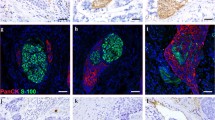Abstract
Objective
The aim of this study was to explore the occurrence and prognostic value of perineural invasion (PNI) as a classic tumor pathological feature in esophageal squamous cell carcinoma (ESCC).
Methods
We retrospectively enrolled 794 ESCC patients who underwent radical esophagectomy at Shanghai Chest Hospital from 2017 to 2018. The incidence, associated factors, and prognosis of PNI were analyzed.
Results
PNI was identified in 15.7% (125/794) of patients. The presence of PNI was significantly associated with depth of invasion (p < 0.001), pN stage (p = 0.008), tumor stage (p < 0.001), and lymphovascular invasion (LVI; p < 0.001). Multivariate logistic regression analysis demonstrated that advanced pT stage and LVI were independently associated with the presence of PNI, while multivariate Cox regression analysis demonstrated that PNI was not an independent risk factor for poor overall survival (OS) or recurrence-free survival (RFS) in ESCC patients (OS hazard ratio [HR] 0.688, 95% confidence interval [CI] 0.448–1.056, p = 0.087; RFS HR 0.837, 95% CI 0.551–1.273, p = 0.406). In the PNI-positive patient subgroup, adjuvant therapy was associated with better OS and RFS.
Conclusion
PNI correlates with, and may be a concomitant consequence of, LVI and advanced tumor invasion (T3–4) in ESCC patients. Although PNI was not identified as an independent prognostic indicator, our results suggest ESCC patients with PNI should be considered for adjuvant therapy.




Similar content being viewed by others
Change history
09 September 2021
A Correction to this paper has been published: https://doi.org/10.1245/s10434-021-10760-1
References
Uhlenhopp DJ, Then EO, Sunkara T, Gaduputi V. Epidemiology of esophageal cancer: update in global trends, etiology and risk factors. Clin J Gastroenterol. 2020;13(6):1010–21.
Yang H, Liu H, Chen Y, et al. Neoadjuvant chemoradiotherapy followed by surgery versus surgery alone for locally advanced squamous cell carcinoma of the esophagus (NEOCRTEC5010): a phase III multicenter, randomized Open-Label Clinical Trial. J Clin Oncol. 2018;36(27):2796–803.
Schmitd LB, Scanlon CS, D’Silva NJ. Perineural invasion in head and neck cancer. J Dent Res. 2018;97(7):742–50.
Schiefer AI, Schoppmann SF, Birner P. Lymphovascular invasion of tumor cells in lymph node metastases has a negative impact on survival in esophageal cancer. Surgery. 2016;160(2):331–40.
Sheng L, Ji Y, Du X. Perineural invasion correlates with postoperative distant metastasis and poor overall survival in patients with PT1-3N0M0 esophageal squamous cell carcinoma. Onco Targets Ther. 2015;8:3153–7.
Liebl F, Demir IE, Mayer K, et al. The impact of neural invasion severity in gastrointestinal malignancies: a clinicopathological study. Ann Surg. 2014;260(5):900–7 (discussion 907–908).
Chen JW, Xie JD, Ling YH, et al. The prognostic effect of perineural invasion in esophageal squamous cell carcinoma. BMC Cancer. 2014;14:313.
Fujikawa H, Koumori K, Watanabe H, et al. The clinical significance of lymphovascular invasion in gastric cancer. In Vivo. 2020;34(3):1533–9.
Liebig C, Ayala G, Wilks JA, Berger DH, Albo D. Perineural invasion in cancer: a review of the literature. Cancer. 2009;115(15):3379–91.
Ochiai M, Arai K, Funabiki T, et al. Local spread of carcinoma of the esophagus by perineural invasion [in Japanese]. Nihon Geka Gakkai Zasshi. 1995;96(3):137–44.
Takubo K, Takai A, Yamashita K, et al. Light and electron microscopic studies of perineural invasion by esophageal carcinoma. J Natl Cancer Inst. 1985;74(5):987–93.
Cao Y, Deng S, Yan L, et al. Perineural invasion is associated with poor prognosis of colorectal cancer: a retrospective cohort study. Int J Colorectal Dis. 2020;35(6):1067–75.
Brandwein-Gensler M, Teixeira MS, Lewis CM, et al. Oral squamous cell carcinoma: histologic risk assessment, but not margin status, is strongly predictive of local disease-free and overall survival. Am J Surg Pathol. 2005;29(2):167–78.
Miller ME, Palla B, Chen Q, et al. A novel classification system for perineural invasion in noncutaneous head and neck squamous cell carcinoma: histologic subcategories and patient outcomes. Am J Otolaryngol. 2012;33(2):212–5.
Liebig C, Ayala G, Wilks J, et al. Perineural invasion is an independent predictor of outcome in colorectal cancer. J Clin Oncol. 2009;27(31):5131–7.
Dell’Atti L. Prognostic significance of perineural invasion in patients who underwent radical prostatectomy for localized prostate cancer. J Buon. 2016;21(5):1219–23.
Ning ZH, Zhao W, Li XD, et al. The status of perineural invasion predicts the outcomes of postoperative radiotherapy in locally advanced esophageal squamous cell carcinoma. Int J Clin Exp Pathol. 2015;8(6):6881–90.
Hsu PK, Chien LI, Lin CH, et al. Impact of perineural invasion as a histopathological prognostic factor in ypStage II/III oesophageal squamous cell carcinoma. Eur J Cardiothorac Surg. 2019;55(5):927–33.
Mao YS, Gao SG, Wang Q, et al. Epidemiological characteristic and current status of surgical treatment for esophageal cancer by analysis of national registry database. Zhonghua Zhong Liu Za Zhi. 2020;42(3):228–33.
Acknowledgments
This study was supported by the Shanghai Chest Hospital Basic Research & Cultivation Project (2019YNJCM13). The authors are grateful to the contribution of Ting Ren and Ruxin Cai, who participated in this study.
Author information
Authors and Affiliations
Corresponding authors
Additional information
Publisher's Note
Springer Nature remains neutral with regard to jurisdictional claims in published maps and institutional affiliations.
The original online version of this article was revised: The formatting of Table 3 was corrected.
Rights and permissions
About this article
Cite this article
Zhang, L., Shao, J., Liu, Z. et al. Occurrence and Prognostic Value of Perineural Invasion in Esophageal Squamous Cell Cancer: A Retrospective Study. Ann Surg Oncol 29, 586–597 (2022). https://doi.org/10.1245/s10434-021-10665-z
Received:
Accepted:
Published:
Issue Date:
DOI: https://doi.org/10.1245/s10434-021-10665-z




